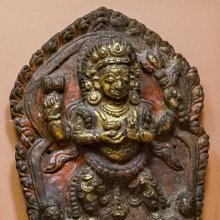Facial expression: 1 definition
Introduction:
Facial expression means something in Hinduism, Sanskrit. If you want to know the exact meaning, history, etymology or English translation of this term then check out the descriptions on this page. Add your comment or reference to a book if you want to contribute to this summary article.
Images (photo gallery)
In Hinduism
Natyashastra (theatrics and dramaturgy)
Source: Shodhganga: Elements of Art and Architecture in the Trtiyakhanda of the Visnudharmottarapurana (natya)Facial Expressions (in Sanskrit Dramas) are denoted by the Sanskrit term Mukhaja and they are conveyed through Āṅgikābhinaya: one of the four divisions of Abhinaya or “ways to convey or represent one’s emotion to others”, according to the Nāṭyaśāstra and the Viṣṇudharmottarapurāṇa, an ancient Sanskrit text which (being encyclopedic in nature) deals with a variety of cultural topics such as arts, architecture, music, grammar and astronomy.—The āṅgikābhinaya includes the histrionic representation of the limbs which is simply known as physical gestures. In the Nāṭyaśāstra, three kinds of physical gestures are accepted. The gestures expressed with major classification of the body parts are termed as: śarīra i.e., physical expression, mukhaja i.e., facial expression and ceṣṭākṛta i.e., different movements of the entire body.

Natyashastra (नाट्यशास्त्र, nāṭyaśāstra) refers to both the ancient Indian tradition (shastra) of performing arts, (natya—theatrics, drama, dance, music), as well as the name of a Sanskrit work dealing with these subjects. It also teaches the rules for composing Dramatic plays (nataka), construction and performance of Theater, and Poetic works (kavya).
See also (Relevant definitions)
Partial matches: Expression.
Query error!
Full-text (+73): Raudra, Mogadummana, Abhinaya, Rukha, Rukh, Ruukh, Vismaya, Drita, Ingita, Vilokita, Hrishta, Jolumore, Nadulunage, Elanage, Elenage, Trasta, Dura, Milita, Shunya, Tripta.
Relevant text
Search found 53 books and stories containing Facial expression, Facial expressions; (plurals include: Facial expressions, Facial expressionses). You can also click to the full overview containing English textual excerpts. Below are direct links for the most relevant articles:
Gati in Theory and Practice (by Dr. Sujatha Mohan)
Nṛtta as a division of Āṅgika-abhinaya < [Chapter 1 - Nāṭya]
Analysis of technical terms: Nāṭya, Nṛtta, Nṛtya < [Chapter 1 - Nāṭya]
Gati used for the delineation of Bhāva and Rasa < [Chapter 3 - Application of gati in Dṛśya-kāvyas]
Abhidhamma in Daily Life (by Ashin Janakabhivamsa) (by Ashin Janakabhivamsa)
Part 3 - Importance Of The Last Minute < [Chapter 8 - What happen when death draws near (mind processes immediately preceding death)]
Part 11 - How Citta Conditions Rupa < [Chapter 10 - Rupa (matter)]
Factor 6 - Adosa (non-anger, loving kindness, forgiveness, harmlessness) < [Chapter 3 - On kusala cetasikas (wholesome mental factors)]
Shishupala-vadha (Study) (by Shila Chakraborty)
Dūta according to the Manusaṃhitā < [Chapter 2a - Activities of ambassador (Dūta)]
Conceptual study of the effect of madhu in neonatal pain management < [Volume 2, issue 5: Sept - Oct 2015]
A Case Study on Bells Palsy and its Ayurvedic Management < [Volume 10, Issue 4: July-August 2023]
Yuvnan pidika - a conceptual study w.s.r. acne vulgaris < [Volume 5, Issue 1: January - February 2018]
World Journal of Pharmaceutical Research
Homeopathic Treatment for Autism: A Case Study Insights < [2021: Volume 10, February issue 2]
Mocharas for analgesia in newborn infants undergoing painful procedures. < [2016: Volume 5, May issue 5]
The era of anxiety and depression < [2022: Volume 11, August issue 11]
